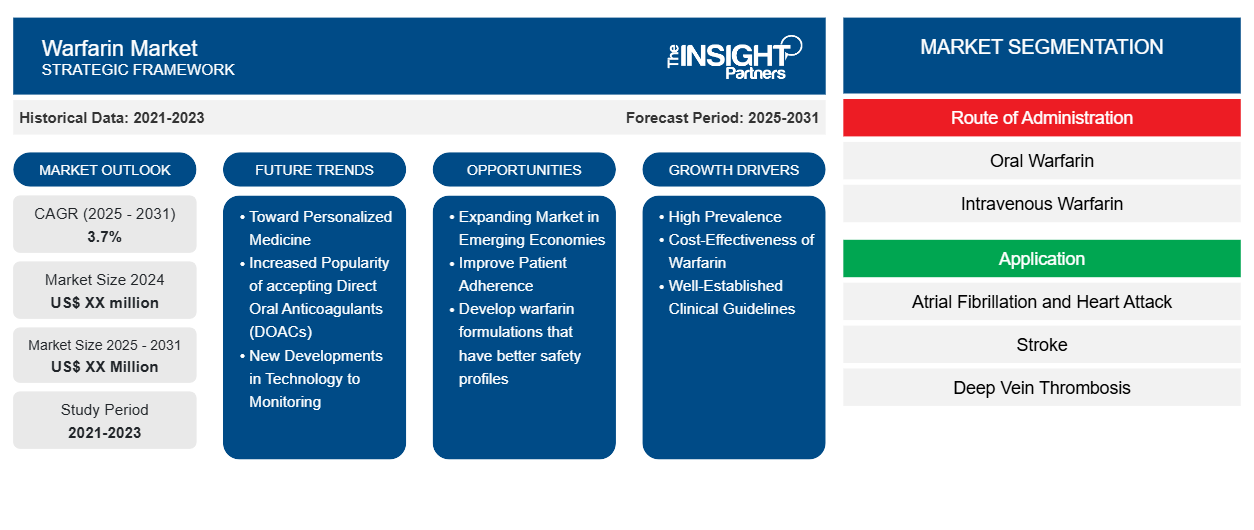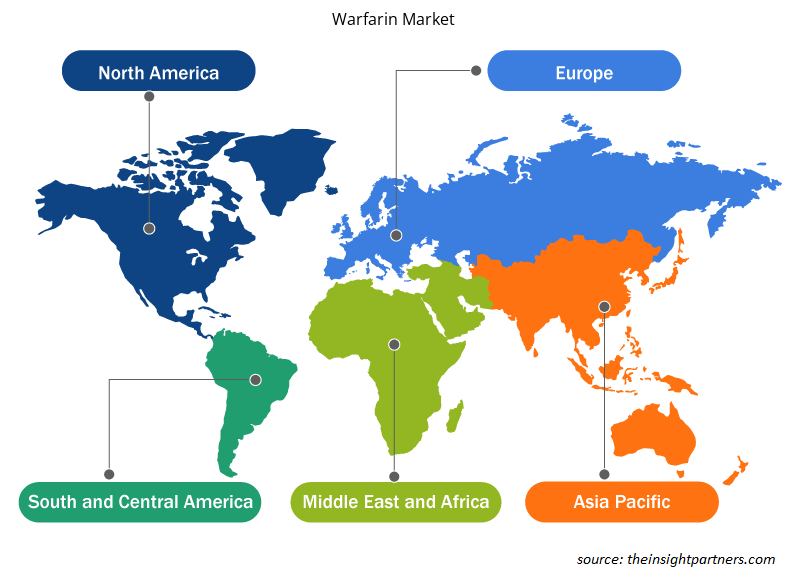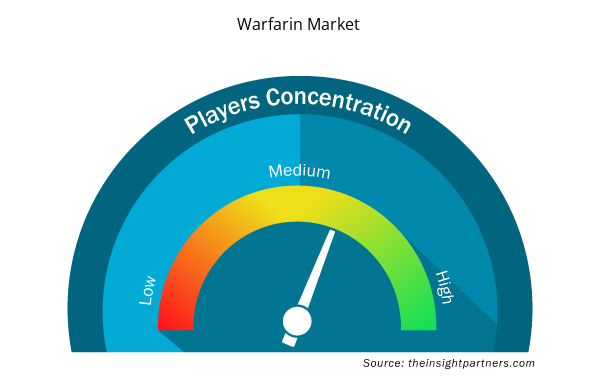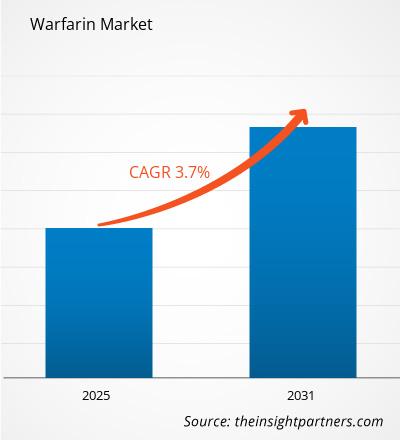The Warfarin Market is expected to register a CAGR of 3.7% from 2025 to 2031, with a market size expanding from US$ XX million in 2024 to US$ XX Million by 2031.
The report is segmented by Route of Administration (Oral Warfarin, and Intravenous Warfarin). The report is segmented by Application (Atrial Fibrillation and Heart Attack, Stroke, Deep Vein Thrombosis (DVT), Pulmonary Embolism (PE), and Others). The global analysis is further broken-down at regional level and major countries. The Report Offers the Value in USD for the above analysis and segments.
Purpose of the Report
The report Warfarin Market by The Insight Partners aims to describe the present landscape and future growth, top driving factors, challenges, and opportunities. This will provide insights to various business stakeholders, such as:
- Technology Providers/Manufacturers: To understand the evolving market dynamics and know the potential growth opportunities, enabling them to make informed strategic decisions.
- Investors: To conduct a comprehensive trend analysis regarding the market growth rate, market financial projections, and opportunities that exist across the value chain.
- Regulatory bodies: To regulate policies and police activities in the market with the aim of minimizing abuse, preserving investor trust and confidence, and upholding the integrity and stability of the market.
Warfarin Market Segmentation
Route of Administration
- Oral Warfarin
- Intravenous Warfarin
Application
- Atrial Fibrillation and Heart Attack
- Stroke
- Deep Vein Thrombosis
- Pulmonary Embolism
Customize This Report To Suit Your Requirement
You will get customization on any report - free of charge - including parts of this report, or country-level analysis, Excel Data pack, as well as avail great offers and discounts for start-ups & universities
Warfarin Market: Strategic Insights

- Get Top Key Market Trends of this report.This FREE sample will include data analysis, ranging from market trends to estimates and forecasts.
Warfarin Market Growth Drivers
- High Prevalence: The growing global burden of cardiovascular diseases such as atrial fibrillation, stroke and deep vein thrombosis (DVT) has continued to promote a continued demand for their anticoagulants such as warfarin. Particularly, atrial fibrillation affects millions of people globally and is one of the leading indications for warfarin therapy. The real need for blood-thinning agents, especially warfarin, has been maintained with the increasing trend in cardiovascular diseases due to age as well as lifestyle habits, such as poor diets and less exercise.
- Cost-Effectiveness of Warfarin: Warfarin's low cost is one of the most important factors that sustain its use. It is much cheaper than new direct oral anticoagulants (doac) that are more expensive, and it will still be preferred in low-income and developing countries where the health resource allocation is poor. It is quite cheap, so it will remain the mainstay for the health system, trying to run a broad population at risk of thromboembolic events.
- Well-Established Clinical Guidelines: Warfarin has been in use for several decades and is hence guided by well-established clinical protocols. As for most healthcare providers, they would be very well aware of the dosing regimen for warfarin, and the therapy monitoring by means of INR tests carried out regularly to ensure appropriate anticoagulation. This aspect of familiarity with warfarin management, along with its predictable pharmacokinetics, brings reassurance to both the doctors and patients and thus it continues to be used in clinical settings.
Warfarin Market Future Trends
- Toward Personalized Medicine: Warfarin is admittedly an established and trusted therapy; however, it is fraught with difficulties, especially with the therapeutic dose for a patient. Personalized medicine is the prescription of drugs according to a person's gene. The dosing of Warfarin is subjected to genetic variations in the above enzymes: CYP2C9 and VKORC1. The most recent trend is genetic testing to specify the dose to be prescribed to individual patients. This approach has so much potential in the future for improving outcomes and reducing damage to such risks.
- Increased Popularity of accepting Direct Oral Anticoagulants (DOACs): From several years now, there has been continuously upgrading market transitions to newer anticoagulants dabigatran, rivaroxaban, and apixaban, which have unrestricted monitoring but less interacted with food and drugs compared with Warfarin. However, Warfarin still counts due to its good and proven history. This competition has made the market of the Warfarin have to adapt along this line, concentrating more and more on creating patient-friendly treatment and preventing complications associated with monitoring.
- New Developments in Technology to Monitoring: The World is Improving the Modality for Monitoring Warfarin Therapy. New Innovative Point-of-Care Devices for Monitoring INR Have Decreased Barriers for the Patients to Manage Their Therapy at Home. These Devices Allow Tests to Take Place Much More Often and More Conveniently, Which Is Helpful in Maintaining Therapeutic Levels of Anticoagulation and Decreasing the Risks of Complications Like Bleeding or Clotting. It Advances Safety in Warfarin Therapy and Makes It More Patient-Friendly.
Warfarin Market Opportunities
- Expanding Market in Emerging Economies: Considerably, expanding markets in emerging economies are likely to see the rise of cardiovascular diseases and an aging population-the markets would offer Warfarin an opportunity. These countries might not have sufficient healthcare budgets to provide for newer anticoagulants. Since Warfarin is affordable, it would be an attractive alternative in such countries. With growing healthcare infrastructure, the market share of Warfarin in these regions will likely grow, especially in Asia, Africa, and Latin America.
- Improve Patient Adherence: The major challenge with warfarin therapy is to keep patients in line with the prescription. Regular INR monitoring, dietary control, and other modalities prescribed by doctors must all be followed. This area is wide open for the improvement of patient education and development of digital health reminders for patients to take medication, go to a monitoring appointment, and avoid certain foods that might interfere with the effects of Warfarin. Incrementing the adherence improves patient outcomes while relieving health dollars spent toward struggling with costly complications from inadequate therapy.
- Develop warfarin formulations that have better safety profiles: Although effective, warfarin can have its safety profile improved with a reduction in risk for major bleeding complications. Development of modified formulations of Warfarin would be another avenue. Controlled release versions are just one idea that might yield a blood concentration more stable with less frequent monitoring. Advances in drug-delivery systems would make Warfarin therapy easier and safer for the patients thus leading to higher satisfaction and greater adherence from patients.
Warfarin Market Regional Insights
The regional trends and factors influencing the Warfarin Market throughout the forecast period have been thoroughly explained by the analysts at Insight Partners. This section also discusses Warfarin Market segments and geography across North America, Europe, Asia Pacific, Middle East and Africa, and South and Central America.

- Get the Regional Specific Data for Warfarin Market
Warfarin Market Report Scope
| Report Attribute | Details |
|---|---|
| Market size in 2024 | US$ XX million |
| Market Size by 2031 | US$ XX Million |
| Global CAGR (2025 - 2031) | 3.7% |
| Historical Data | 2021-2023 |
| Forecast period | 2025-2031 |
| Segments Covered |
By Route of Administration
|
| Regions and Countries Covered | North America
|
| Market leaders and key company profiles |
Warfarin Market Players Density: Understanding Its Impact on Business Dynamics
The Warfarin Market market is growing rapidly, driven by increasing end-user demand due to factors such as evolving consumer preferences, technological advancements, and greater awareness of the product's benefits. As demand rises, businesses are expanding their offerings, innovating to meet consumer needs, and capitalizing on emerging trends, which further fuels market growth.
Market players density refers to the distribution of firms or companies operating within a particular market or industry. It indicates how many competitors (market players) are present in a given market space relative to its size or total market value.
Major Companies operating in the Warfarin Market are:
- Aspen Holdings
- Bayer AG
- Boehringer Ingelheim GmbH
- Bristol-Myers Squibb Company
- Daiichi Sankyo Company, Limited
Disclaimer: The companies listed above are not ranked in any particular order.

- Get the Warfarin Market top key players overview
Key Selling Points
- Comprehensive Coverage: The report comprehensively covers the analysis of products, services, types, and end users of the Warfarin Market, providing a holistic landscape.
- Expert Analysis: The report is compiled based on the in-depth understanding of industry experts and analysts.
- Up-to-date Information: The report assures business relevance due to its coverage of recent information and data trends.
- Customization Options: This report can be customized to cater to specific client requirements and suit the business strategies aptly.
The research report on the Warfarin Market can, therefore, help spearhead the trail of decoding and understanding the industry scenario and growth prospects. Although there can be a few valid concerns, the overall benefits of this report tend to outweigh the disadvantages.
- Historical Analysis (2 Years), Base Year, Forecast (7 Years) with CAGR
- PEST and SWOT Analysis
- Market Size Value / Volume - Global, Regional, Country
- Industry and Competitive Landscape
- Excel Dataset



Report Coverage
Revenue forecast, Company Analysis, Industry landscape, Growth factors, and Trends

Segment Covered
This text is related
to segments covered.

Regional Scope
North America, Europe, Asia Pacific, Middle East & Africa, South & Central America

Country Scope
This text is related
to country scope.
Frequently Asked Questions
Players operating in the market are Aspen Holdings, Bayer AG, Boehringer Ingelheim GmbH, Bristol-Myers Squibb Company, Daiichi Sankyo Company, GlaxoSmithKline plc., Johnson & Johnson (Janssen Pharmaceuticals, Inc.), Pfizer, Inc., Portola Pharmaceuticals, Inc., Sanofi S.A
Oral Warfarin segment, by Route of Administration, dominated the market in 2023.
Expanding Market in Emerging Economies act as a opportunity for growth of the market in forecast period.
North America region dominated the Warfarin market in 2023.
The Warfarin Market is estimated to witness a CAGR of 3.7% from 2023 to 2031
The major factors driving the Warfarin market are:
1. High Prevalence
2. Cost-Effectiveness of Warfarin
Trends and growth analysis reports related to Life Sciences : READ MORE..
1. Aspen Holdings
2. Bayer AG
3. Boehringer Ingelheim GmbH
4. Bristol-Myers Squibb Company
5. Daiichi Sankyo Company, Limited
6. GlaxoSmithKline plc.
7. Johnson & Johnson (Janssen Pharmaceuticals, Inc.)
8. Pfizer, Inc.
9. Portola Pharmaceuticals, Inc.
10. Sanofi S.A

 Get Free Sample For
Get Free Sample For